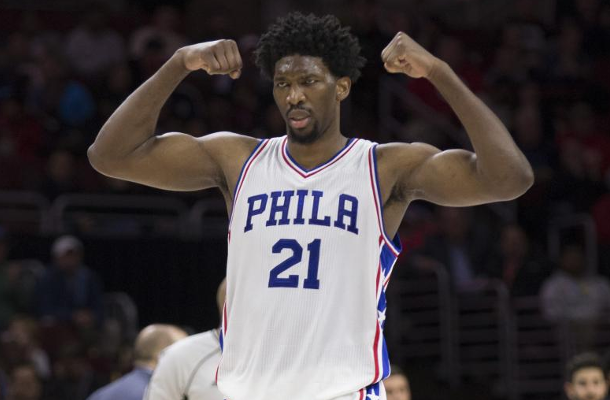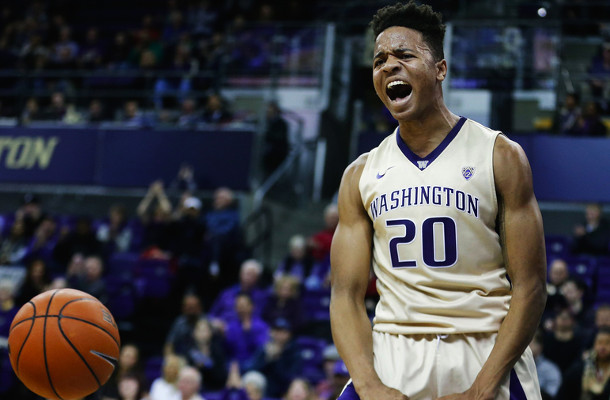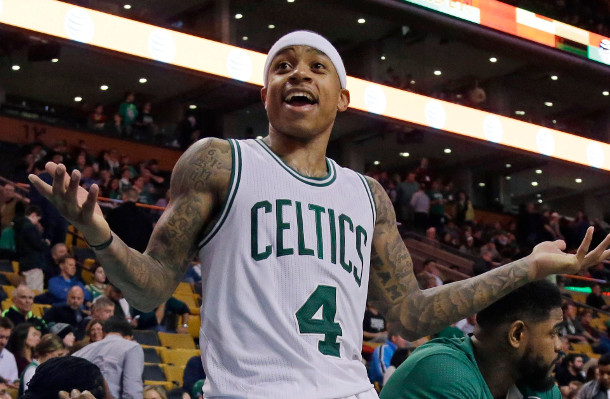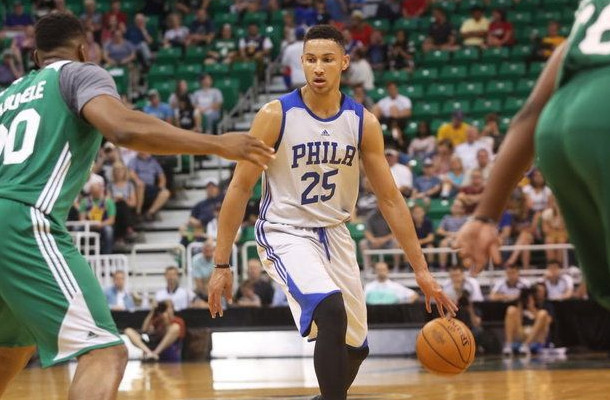Sixers slow pace not indicative of a lack of progress
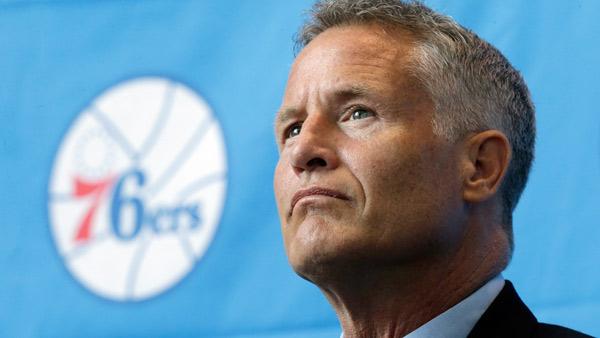 When?
When?
When will the Sixers be competitive? When will they start caring about winning? When will this all come together?
It’s been the most asked question, by far, about the team this season. If somebody — on sports talk radio, in a coffee shop, at a Brett Brown press conference — is talking about the Sixers, the odds are pretty good that the question of when the Sixers will make winning a priority is bound to be brought up.
The thing is, the question has been answered. Repeatedly. Ever since Sam Hinkie commented on the Michael Carter-Williams trade, the organization has been consistent in their message of when they will compete.
The Sixers will compete when they have drafted, and developed, the superstar level talent required to compete.
“Every decision we make, every move we make, will be consistent with our long running strategy, which is to grab NBA stars,” Sixers majority owner Joshua Harris told reporters earlier this week.
“It’s really hard to put a time frame on it because it kind of comes down to it’s a players league. We’re going to continue to try to add elite NBA players,” Harris said. “When we get them and how we get them is going to determine when we can be in a position to compete.
“We’re as impatient as you are,” Harris continued. “We want it to happen as quickly as we can, but we can’t predict that.”
That focus on wins, the ultimate goal of sports, clouds the state of actual progress.
It’s not that wins themselves are bad. As previously mentioned, they’re the ultimate goal of sports. They’re what the Sixers front office is building towards.
It’s that wins, if they’re coming in place of the acquisition and development of a superstar, is, at best, misleading. At worst, if the moves to get those wins eat into your cap space or limit the chance of getting elite talent in the draft, can be counter-productive.
“To move it forward, we need needle movers. We need talent,” Sixers head coach Brett Brown said.”When do you overreact? When do you blink, and just feel like enough is enough, and we have to do it now? That’s when dangerous things happen.
“We’ll move forward as the players help us,” Brown concluded.
“I do believe that taking your eye off of making decisions which will add the best players over time will not result in achieving our goal,” Harris said. “I don’t want to set an artificial timeline.”
That kind of overreaction that Brown was talking about, or taking your eye off of adding the best talent that Harris described, is the type of thought process that can lead to passing on Nerlens Noel. Even now, even only a year into Noel’s NBA career, it’s become obvious that Noel’s missed season is irrelevant.
Passing on Noel, instead opting for guys like Anthony Bennett, Otto Porter, Cody Zeller, or Alex Len because they could play now, because they needed to move the needle forward immediately, was a huge mistake.
The desire for immediate clouded the judgment of people who needed significant. That’s a mistake the 76ers are determined not to make.
In time, if Joel Embiid is who they think he is, and if Dario Saric develops into who they hope he will become, that wait, the wait we’re constantly debating, will be irrelevant. The 76ers need talent, and their ability to draft, identify, and develop talent is what will determine their success.
Waiting for, and developing, talent is not kicking the can down the road. Failing to grab elite talent when it is available is.
That intense focus on finding elite players can lead to some volatility, as the team witnessed with the Michael Carter-Williams trade.
“I think sometimes when you’re trying to build a winner, and you’re looking for elite players, you have to make hard decisions,” Harris said. “I think we’re building the culture, the process, the system. I think it’s all working. I think a little bit of change is not going to hurt it.”
Sixers head coach Brett Brown, speaking mere minutes after Harris, seemed to contradict that somewhat.
“At the end of the day, to coach gypsies, that’s not what I’m looking for,” Sixers head coach Brett Brown told the media before their final game of the season, a statement that seemingly had an air of defiance and dissatisfaction that we don’t typically see from the normally upbeat and on-board coach.
“That doesn’t mean we have to be pregnant with average players,” Brown immediately clarified. “We’re looking for people that can move it forward in a big way. And so if there is a volatility that comes our way because of that, then so be it. Consistency and carryover can’t trump the fact that we’re looking for talent.”
The two statements, just seconds apart from one another, would almost seem to be at odds. How can you avoid turnover while embracing volatility?
Was Brett Brown simply trying to back off from his bold statement? Did he realize the mistake that he made, and was looking to limit the damage?
Or is there a way to reconcile those two seemingly competing beliefs?
The Sixers right now are in their own version of survival of the fittest, drafting as much pedigreed talent as possible and letting the cream rise to the top.
Some of the selections will work out, some of them will not. The draft, as has been oft-mentioned, is far from an exact science. Over time the Sixers will separate out those worth building around from those who are not.
It’s a process the Sixers just went through with Michael Carter-Williams. If the Sixers felt Carter-Williams was a difference maker, a true franchise talent, a true fit with Joel Embiid and the rest of the team they’re building, he’d still be here. Taking Carter-Williams at 11 in a bad draft was worth the risk, but at some point a decision must be made on the probability of him becoming great, especially if another team is offering a potential top draft pick, the rarest of assets to be moved in a trade, in return for him.
As Brown said, you can’t let yourself become beholden to average.
That volatility, despite the outcry, isn’t all that uncommon for teams looking to form an identity and build their foundation.
There was a point, not all that long ago when measured by calendar years but eons ago in comparison to the 67 win juggernaut they’ve become, where Golden State thought their 22 year old, dynamic scoring guard Monta Ellis, fresh off of a 20.2 point per game season, was their face of the franchise. There was a time when Chicago drafted Ben Gordon to be the cornerstone of their rebuilding efforts.
Neither of these scenarios, of course, ended up playing themselves out. Both of these teams, eventually, after a little bit of trial and error, found their true franchise players in Stephen Curry and Derrick Rose, then complemented them with Klay Thompson and Joakim Noah. Ellis was eventually traded for Andrew Bogut, a more pressing need as a complementary player who could help hide, and feed off of, Curry’s weaknesses. Gordon was allowed to sign elsewhere when his contract expired.
Michael Carter-Williams received the lions share of attention during the first 1.5 years of the Sam Hinkie era. Not because he was the best talent, not because he was the most likely to be a franchise player, and not because the Sixers had invested so much in him that he was crucial to what they were doing. Carter-Williams became the center of attention because he was the first: the first to be brought in, the first to pique our interest, the first to get us excited.
Like Ellis and Gordon, simply being the first wasn’t reason enough to be the franchise centerpiece.
That process — the process of drafting, evaluating, developing, and determining long term fit — is one that almost always happens. The Lakers, at one point, thought they had a real catch with Eddie Jones. They did, but Kobe Bryant was the real needle mover. The Clippers, at one point, were really invested in Eric Gordon, until injuries, reality, and the availability of Chris Paul changed their course.
That type of turnover is natural. Nigh, it’s necessary. Fighting that natural consequence of the stage of the rebuild the Sixers are in because of an artificial desire for consistency and immediate mediocrity is counter-productive.
Where Brett Brown and the Sixers do need consistency is in finding a core. Finding a player, or two, or perhaps three, who can legitimately be the focal point of the franchise. Finding the stars that are then worth complementing.
The Sixers need to find their Tim Duncan, Tony Parker, and Manu Ginobili. They need their Dwight Howard and James Harden. With that consistency in place, the rest of the pieces begin to make sense, and the goal of the franchise shifts to finding complementary pieces, and to winning.
So the Sixers will continue to do everything that they can to draft, and develop, elite NBA players. That doesn’t mean that every draft pick will be a success, or that every young talent will be here for a decade. It never is like that, and every time change happens does not constitute a setback.
And, once they’re successful in that phase, the Sixers will win. They will win organically. They will win because they succeeded in step 1, because the foundation of getting to the final step, an NBA championship, is in place, not because they were desperate to get to step 2 as quickly as possible.
“There are shortcuts to the middle,” Joshua Harris concluded his press conference with. “There are not shortcuts to the top.”
Related Posts
-
AaronMcKie4MVP
-
AaronMcKie4MVP


